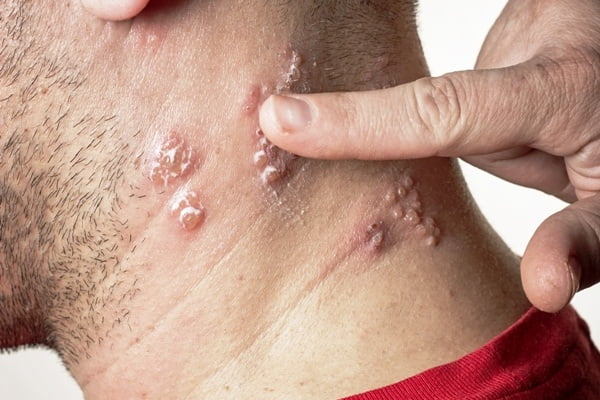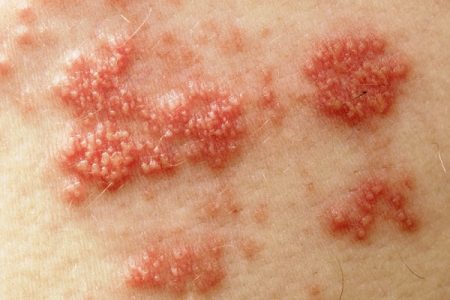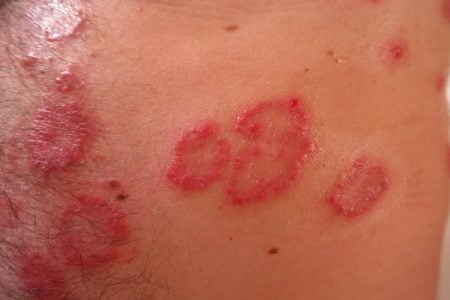What is Shingles?
Shingles is an infectious viral disease. It occurs due to infection from varicella zoster virus. This infection leads to the development of blistering rashes which are painful and cause a tingling sensation. Shingles mostly occurs as a complication, after a person experiences chicken pox.
The Centers for Disease Control and Prevention (CDC) states that about 1 million people can develop shingles, each year in the United States. It is not a life-threatening condition, in major instances.
What does Shingles look like?
Shingles is caused due to viral infection which resides in nerves of your body. Due to which, the symptoms of activated virus appear along the nerves.
The most common and significant sign of shingles is appearance of rashes on the skin. These rashes appear in a stripe or band-like pattern along a nerve pathway, which is known as dermatome. Usually, these rashes affect on only side of the body, mostly without crossing the midline.
Initially, rashes appear as red or pink blotchy patches on your skin or discoloration of the affected skin surface, which may develop into blisters. Blisters appear similar to chicken pox.
Where do shingles symptoms appear: on Arm or Back?
Rashes or blisters, associated as signs of shingles, can appear throughout the body. Mostly they appear on the face and torso and in rare cases; rashes may appear on the lower body.
Some major regions where signs of shingles develop are as follows:
Shingles Belt
In most cases, shingle rashes appear around the rib cage or waist, where they appear as a belt or half belt. Such shingle blisters are also referred to as shingles band or shingles girdle. This belt covers an extensive area of any one side of your midsection. It also creates difficulty if you wear tight cloths.
Shingles belt is one of the symptoms which only appears in shingles, whereas, there are certain other shingle symptoms which may appear during chicken pox or other viral infections too.
Ophthalmic Shingles
Ophthalmic shingles occurs when zoster virus affects the facial nerves which control facial movement and sensations on your face. In such a case, blisters appear around your eyes, forehead and nose. You may even experience headache.
Other symptoms associated with ophthalmic shingles involve redness and swelling in your eyes, drooping eyelids and inflammation in the cornea or iris. In some cases, it can even lead to blurred vision or double vision.
Widespread shingles
According to CDC, US, about 20 million of shingle patients may develop multiple blisters along various dermatomes. Dermatomes are those skin surfaces which are supplied with separate spinal nerves.
If you experience blisters on three or more dermatomes, it is referred to as disseminated or widespread zoster infection. In such cases, the rashes are quite similar to the ones which appear during chickenpox. Widespread shingles occur if you have a weak immune system.
Signs of Early Shingles: What does Mild Shingles look like?
The early symptoms of shingles involve fever and general weakness in patients. In the affected region, you may experience shingles pain, burning and tingling sensation. After a few days, rashes may appear on the affected region. During the onset of shingles, they are not contagious.
Common Signs of Shingles
Shingles may develop various sensations and changes on the skin surface. Out of these signs, the most common symptoms which indicate skin surface changes are as follows:
Blisters
With the onset of shingles, rashes appear on the skin surface. With the growth of virus in the nerve cells, rashes get converted to blisters, which are fluid-filled. Blisters lead to itching in the affected region, thereby leading to the formation of new blisters.
Blisters usually appear over a localized region of your body and do not spread throughout the body.
Active blisters are highly contagious and can lead to transmission of the virus from the affected individual to a non-infected individual.
Scabbing and Crusting
As the varicella zoster virus grows in the nerves, the appearance of blisters may change. Blister will erupt and ooze out the fluid. After the fluid is released, they may turn yellow and then brown and may lead to flattening the skin surface. With times, these blisters will dry off and scabs will be formed. It takes about one to two weeks for blisters to completely crust over.
During scabbing and crusting of blisters, pain in the affected region may ease a little. In some cases, it may continue for years. The blisters may crust over in 7 to 10 days and they may completely clear off in about 2 to 4 weeks.
When the blisters crust over, they are highly contagious and contact with unaffected or risk associated people should be avoided, during this period, such as infants, pregnant women and immune-compromised individuals. Once all your blisters get crust, there does not remain any risk of transmission of the virus.
What do shingles feel like?
When signs of shingles start appearing, patients may experience burning, itching, tingling and stinging sensation over the specific skin surface. Within a few days, rashes may develop on these regions. In extreme cases, patients may experience severe pain and rigorous skin sensitivity. You may experience other symptoms along with sensitivity on the skin such as headache, fever, chills, malaise, nausea, body aches and swollen lymph nodes.
How to identify if you suffer from Shingles only?
There is a possibility that shingles may be confused with other skin diseases such as psoriasis, hives or eczema.
The specific characteristic of skin rashes helps the doctor diagnose the type of disease. For example, in hives, rashes are raised from the skin surface and appear as welts. In psoriasis, rashes have red patches along with white scales throughout its surface.
Another characteristic difference which helps doctors differentiate between shingle rashes and other skin rashes is based upon the pattern of development of rashes. Shingle rashes mainly develop along the nerves of the chest and belly, whereas rashes due to some skin infection or eczema mainly develop in legs and arms.
Rashes which occur during shingles are extremely painful as compared to other rashes which occur during psoriasis, hives or eczema.
Shingle rashes usually appear on any one side of the body. If you observe rashes on both sides of your body, it may not be due to shingles. If you suspect it may be a sign of singles, contact your healthcare provider immediately.







